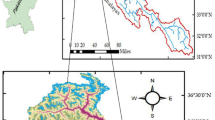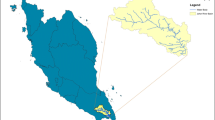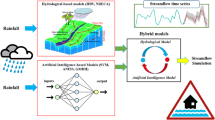Abstract
Accurate streamflow prediction is indispensable for efficient water resources management. In recent years, numerous investigations have utilized artificial intelligence (AI) and machine learning (ML) approaches for forecasting streamflows. The objective of this study is to assess eight AI techniques for predicting river flows. The ML models include adaptive neuro fuzzy inference system (ANFIS), support vector regression (SVR), M5P model tree, adaptive boosting (AdaBoost), genetic programming (GP), gradient boosting regression (GBR), extreme gradient boosting regression (XGBoost), and K-nearest neighbors (KNN). The daily discharges of the Dez River measured at the Telezang station between 2011 and 2022 were used in this study. Based on the obtained results, ANFIS outperformed other ML models examined in this study based on six criteria. Furthermore, the uncertainty analysis was conducted. The results demonstrated that the ANFIS model achieved the best river flow estimations, followed by the GBR model. In terms of the reliability of the experimental dataset, ANFIS and GBR indicated outstanding results, achieving uncertainty percentages of 96.77 and 93.55, respectively, signifying their excellent performance. It is postulated that the achieved results not only can be exploited as an input for hydrological modeling but also can help authorities to conduct better river management.









Similar content being viewed by others
Data availability
The data that support the findings of this study are available from the corresponding author upon reasonable request.
References
Abbasi M, Farokhnia A, Bahreinimotlagh M, Roozbahani R (2021) A hybrid of random forest and deep auto-encoder with support vector regression methods for accuracy improvement and uncertainty reduction of long-term streamflow prediction. J Hydrol 597:125717
Abbasi M, Dehban H, Farokhnia A, Roozbahani R, Bahreinimotlagh M (2022) Long-term streamflow prediction using hybrid SVR-ANN based on bayesian model averaging. J Hydrol Eng 27(11):05022018
Abrahart RJ, See L (1998) Neural network vs. ARMA modelling: constructing benchmark case studies of river flow prediction. In: GeoComputation’98. Proceedings of the Third International Conference on GeoComputation, University of Bristol, United Kingdom
Adnan RM, Liang Z, Parmar KS, Soni K, Kisi O (2021) Modeling monthly streamflow in mountainous basin by MARS, GMDH-NN and DENFIS using hydroclimatic data. Neural Comput Appl 33(7):2853–2871
Almasi SN, Bagherpour R, Mikaeil R, Ozcelik Y, Kalhori H (2017) Predicting the building stone cutting rate based on rock properties and device pullback amperage in quarries using M5P model tree. Geotech Geol Eng 35(4):1311–1326
Anusree K, Varghese KO (2016) Streamflow prediction of Karuvannur river basin using ANFIS, ANN and MNLR models. Procedia Technol 24:101–108
Awad M, Khanna R (2015) Support vector regression. efficient learning machines: theories, concepts, and applications for engineers and system designers. In: Awad M, Khanna R (eds.), Apress, Berkeley, pp 67–80
Aytek A, Asce M, Alp M (2008) An application of artificial intelligence for rainfall-runoff modeling. J Earth Syst Sci 117(2):145–155
Azarpira F, Shahabi S (2021) Evaluating the capability of hybrid data-driven approaches to forecast monthly streamflow using hydrometric and meteorological variables. J Hydroinf 23(6):1165–1181
Behnood A, Behnood V, Modiri Gharehveran M, Alyamac KE (2017) Prediction of the compressive strength of normal and high-performance concretes using M5P model tree algorithm. Constr Build Mater 142:199–207
Borrelli A, Falco I, Della Cioppa A, Nicodemi M, Trautteur G (2006) Performance of genetic programming to extract the trend in noisy data series. Physica A 370:104–108
Cao Y, Miao Q-G, Liu J-C, Gao L (2013) Advance and prospects of AdaBoost algorithm. Acta Automatica Sinica 39(6):745–758
Chang F-J, Chen Y-C (2001) A counterpropagation fuzzy-neural network modeling approach to real time streamflow prediction. J Hydrol 245:153–164
Chen T, Guestrin C (2016) Xgboost: a scalable tree boosting system. In: Proceedings of the 22nd acm sigkdd international conference on knowledge discovery and data mining
Cigizoglu HK (2003) Estimation, forecasting and extrapolation of river flows by artificial neural networks. Hydrol Sci J 48(3):349–361
De Gregorio L, Callegari M, Mazzoli P, Bagli S, Broccoli D, Pistocchi A, Notarnicola C (2018) Operational river discharge forecasting with support vector regression technique applied to alpine catchments: results, advantages, limits and lesson learned. Water Resour Manag 32(1):229–242
Essam Y, Huang YF, Ng JL, Birima AH, Ahmed AN, El-Shafie A (2022) Predicting streamflow in Peninsular Malaysia using support vector machine and deep learning algorithms. Sci Rep 12(1):3883
Fix E, Hodges J (1951) Discriminatory analysis, nonparametric discrimination
Freund Y, Schapire R, Abe N (1999) A short introduction to boosting. J Jpn Soc Artif Intell 14(771–780):1612
Friedman JH (2002) Stochastic gradient boosting. Comput Stat Data Anal 38(4):367–378
Goodarzi MR, Niknam ARR, Barzkar A, Niazkar M, Zare Mehrjerdi Y, Abedi MJ, Heydari Pour M (2023a) Water quality index estimations using machine learning algorithms: a case study of Yazd-Ardakan Plain, Iran. Water 15(10):1876
Goodarzi MR, Niknam ARR, Rahmati SH, Attar NF (2023b) Assessing land use changes’ effect on river water quality in the Dez Basin using land change modeler. Environ Monit Assess 195(6):774
Goodarzi MR, Niknam ARR, Barzkar A, Shishebori D (2023c) River water flow prediction rate based on machine learning algorithms: a case study of Dez River, Iran. In: Pandey M, Gupta AK, Oliveto G (eds) River, sediment and hydrological extremes: causes, impacts and management. Springer Nature Singapore, Singapore, pp 203–219
Guan J, Zurada J, Levitan A (2008) An adaptive neuro-fuzzy inference system based approach to real estate property assessment. J Real Estate Res 30:395–422
He F, Zhang H, Wan Q, Chen S, Yang Y (2023) Medium term streamflow prediction based on Bayesian model averaging using multiple machine learning models. Water 15(8):1548
Huang W, Xu B, Chan Hilton A (2004) Forecasting flows in Apalachicola River using neural networks. Hydrol Process 18:2545–2564
Hussain D, Khan A (2020) Machine learning techniques for monthly river flow forecasting of Hunza River, Pakistan. Earth Sci Inf 13:1–11
Ibrahim KSMH, Huang YF, Ahmed AN, Koo CH, El-Shafie A (2022) A review of the hybrid artificial intelligence and optimization modelling of hydrological streamflow forecasting. Alex Eng J 61(1):279–303
Jang JSR (1993) ANFIS: adaptive-network-based fuzzy inference system. IEEE Trans Syst Man Cybern 23(3):665–685
Jung N-C, Popescu I, Kelderman P, Solomatine DP, Price RK (2010) Application of model trees and other machine learning techniques for algal growth prediction in Yongdam reservoir, Republic of Korea. J Hydroinf 12(3):262–274
Kalcheva N, Todorova M, Marinova G (2020) Naive Bayes classifier, decision tree and AdaBoost ensemble algorithm-advantages and disadvantages. Knowl Based Sustain Dev 2020:153
Khazaee Poul A, Shourian M, Ebrahimi H (2019) A comparative study of MLR, KNN, ANN and ANFIS models with wavelet transform in monthly stream flow prediction. Water Resour Manag 33(8):2907–2923
Kouadri S, Kateb S, Zegait R (2021) Spatial and temporal model for WQI prediction based on back-propagation neural network, application on EL MERK region (Algerian southeast). J Saudi Soc Agric Sci 20(5):324–336
Koza JR (1994) Genetic programming as a means for programming computers by natural selection. Stat Comput 4(2):87–112
Kumar V, Kedam N, Sharma KV, Mehta DJ, Caloiero T (2023) Advanced machine learning techniques to improve hydrological prediction: a comparative analysis of streamflow prediction models. Water 15(14):2572
Maity R, Kashid SS, Bhatnagar A (2009) Hydrometerological modeling approaches using support vector regression (SVR) and genetic programming (GP). ISH J Hydra Eng 15(sup1):244–257
McRoberts RE (2012) Estimating forest attribute parameters for small areas using nearest neighbors techniques. For Ecol Manag 272:3–12
Mehdizadeh S, Fathian F, Adamowski JF (2019) Hybrid artificial intelligence-time series models for monthly streamflow modeling. Appl Soft Comput 80:873–887
Nayak PC, Sudheer KP, Rangan DM, Ramasastri KS (2004) A neuro-fuzzy computing technique for modeling hydrological time series. J Hydrol 291(1):52–66
Nhu V-H, Shahabi H, Nohani E, Shirzadi A, Al-Ansari N, Bahrami S, Miraki S, Geertsema M, Nguyen H (2020) Daily water level prediction of Zrebar Lake (Iran): a comparison between M5P, random forest, random tree and reduced error pruning trees algorithms. ISPRS Int J Geo Inf 9(8):479
Niazkar M, Zakwan M (2023) Developing ensemble models for estimating sediment loads for different times scales. In: Environment, Development and Sustainability, pp 1–19
Niazkar M (2022) Appraisal of multigene genetic programming for estimating optimal properties of lined open channels with circular shapes incorporating constant and variable roughness scenarios. In: Zakwan M, Wahid A, Niazkar M, Chatterjee U (eds) Chapter 17 in current directions in water scarcity research. Elsevier, pp 285–297
Niazkar M (2023) Multigene genetic programming and its various applications, Handbook of Hydroinformatics (ISBN: 978-0-12-821285-1), Elsevier, pp 321–332
Noori R, Karbassi AR, Moghaddamnia A, Han D, Zokaei-Ashtiani MH, Farokhnia A, Gousheh MG (2011) Assessment of input variables determination on the SVM model performance using PCA, Gamma test, and forward selection techniques for monthly stream flow prediction. J Hydrol 401(3):177–189
Onyari E, Ilunga F (2013) Application of MLP neural network and M5P model tree in predicting streamflow: a case study of Luvuvhu Catchment, South Africa. Int J Innov Manag Technol 4:11–15
Patle A, Chouhan DS (2013) SVM kernel functions for classification. In: 2013 International Conference on Advances in Technology and Engineering (ICATE)
Pham TD, Le NN, Ha NT, Nguyen LV, Xia J, Yokoya N, To TT, Trinh HX, Kieu LQ, Takeuchi W (2020) Estimating mangrove above-ground biomass using extreme gradient boosting decision trees algorithm with fused sentinel-2 and ALOS-2 PALSAR-2 data in can gio biosphere reserve, Vietnam. Remote Sens 12(5):777
Pham BT, Ly H-B, Al-Ansari N, Ho LS (2021) A comparison of gaussian process and M5P for prediction of soil permeability coefficient. Sci Program 2021:3625289
Piraei R, Afzali SH, Niazkar M (2023) Assessment of XGBoost to estimate total sediment loads in rivers. Water Resour Manag. https://doi.org/10.1007/s11269-023-03606-w
Quinlan JR (1992) Learning with continuous classes. In: 5th Australian joint conference on artificial intelligence, World Scientific
Rasouli K, Hsieh WW, Cannon AJ (2012) Daily streamflow forecasting by machine learning methods with weather and climate inputs. J Hydrol 414–415:284–293
Saberi-Movahed F, Najafzadeh M, Mehrpooya A (2020) Receiving more accurate predictions for longitudinal dispersion coefficients in water pipelines: training group method of data handling using extreme learning machine conceptions. Water Resour Manag 34(2):529–561
Saghafian B, Anvari S, Morid S (2013) Effect of Southern Oscillation Index and spatially distributed climate data on improving the accuracy of artificial neural network, adaptive neuro-fuzzy inference system and K-nearest neighbour streamflow forecasting models. Expert Syst 30(4):367–380
Sahoo BB, Jha R, Singh A, Kumar D (2019) Application of support vector regression for modeling low flow time series. KSCE J Civ Eng 23(2):923–934
Samadianfard S, Jarhan S, Salwana E, Mosavi A, Shamshirband S, Akib S (2019) Support vector regression integrated with fruit fly optimization algorithm for river flow forecasting in Lake Urmia Basin. Water 11(9):1934
Schapire RE (2013) Explaining adaboost. Empirical inference: Festschrift in Honor of Vladimir N. Vapnik, pp 37–52
Solomatine D, Ostfeld A (2008) Data-driven modelling: some past experiences and new approaches. J Hydroinform 10:3
Terzi Ö, Ergin G (2014) Forecasting of monthly river flow with autoregressive modeling and data-driven techniques. Neural Comput Appl 25(1):179–188
Tongal H, Booij M (2018) Simulation and forecasting of streamflows using machine learning models coupled with base flow separation. J Hydrol 564:266
Troin M, Arsenault R, Wood AW, Brissette F, Martel J-L (2021) Generating ensemble streamflow forecasts: a review of methods and approaches over the past 40 years. Water Resour Res 57(7):e2020WR028392
Vapnik V (1999) The nature of statistical learning theory. Springer science & business media
Wang C, Xu S, Yang J (2021) Adaboost algorithm in artificial intelligence for optimizing the IRI prediction accuracy of asphalt concrete pavement. Sensors 21(17):5682
Wang Y, Witten I (1997) Induction of model trees for predicting continuous classes. Induction of model trees for predicting continuous classes
Wei Z, Meng Y, Zhang W, Peng J, Meng L (2019) Downscaling SMAP soil moisture estimation with gradient boosting decision tree regression over the Tibetan Plateau. Remote Sens Environ 225:30–44
Witten IH, Frank E, Hall MA, Pal CJ, Data M (2005) Practical machine learning tools and techniques. Data mining
Wu C, Chau K, Fan C (2010) Prediction of rainfall time series using modular artificial neural networks coupled with data-preprocessing techniques. J Hydrol 389:146–167
Yang T, Asanjan AA, Welles E, Gao X, Sorooshian S, Liu X (2017) Developing reservoir monthly inflow forecasts using artificial intelligence and climate phenomenon information. Water Resour Res 53(4):2786–2812
Yaseen ZM, El-shafie A, Jaafar O, Afan HA, Sayl KN (2015) Artificial intelligence based models for stream-flow forecasting: 2000–2015. J Hydrol 530:829–844
Yi H-S, Lee B, Park S, Kwak K-C, An K-G (2019) Prediction of short-term algal bloom using the M5P model-tree and extreme learning machine. Environ Eng Res 24(3):404–411
Yuan J, Wang K, Yu T, Fang M (2008) Reliable multi-objective optimization of high-speed WEDM process based on Gaussian process regression. Int J Mach Tools Manuf 48(1):47–60
Zadeh LA (1996) Key roles of information granulation and fuzzy logic in human reasoning, concept formulation and computing with words. In: Proceedings of IEEE 5th International Fuzzy Systems
Funding
The authors declare that no funds, grants, or other support was received during the preparation of this manuscript.
Author information
Authors and Affiliations
Contributions
All authors contributed to the study conception and design. Material preparation and data collection were performed by MRG, MN, ARRN. Also, Analysis and modeling were performed by all authors. The first draft of the manuscript was written by MN, ARRN and AB, and all authors commented on previous versions of the manuscript. All authors read and approved the final manuscript.
Corresponding author
Ethics declarations
Conflict of interest
The authors have no relevant financial or non-financial interests to disclose.
Additional information
Publisher's Note
Springer Nature remains neutral with regard to jurisdictional claims in published maps and institutional affiliations.
Rights and permissions
Springer Nature or its licensor (e.g. a society or other partner) holds exclusive rights to this article under a publishing agreement with the author(s) or other rightsholder(s); author self-archiving of the accepted manuscript version of this article is solely governed by the terms of such publishing agreement and applicable law.
About this article
Cite this article
Goodarzi, M.R., Niazkar, M., Barzkar, A. et al. Assessment of machine learning models for short-term streamflow estimation: the case of Dez River in Iran. Sustain. Water Resour. Manag. 10, 33 (2024). https://doi.org/10.1007/s40899-023-01021-y
Received:
Accepted:
Published:
DOI: https://doi.org/10.1007/s40899-023-01021-y




